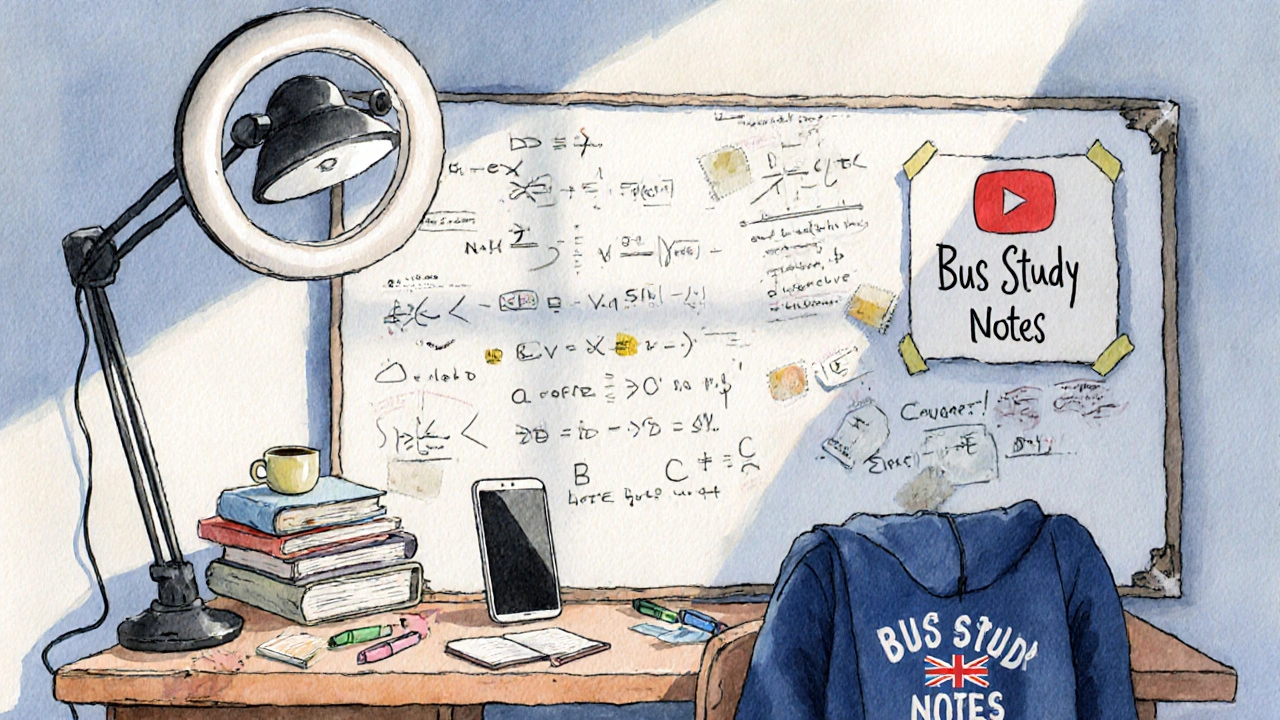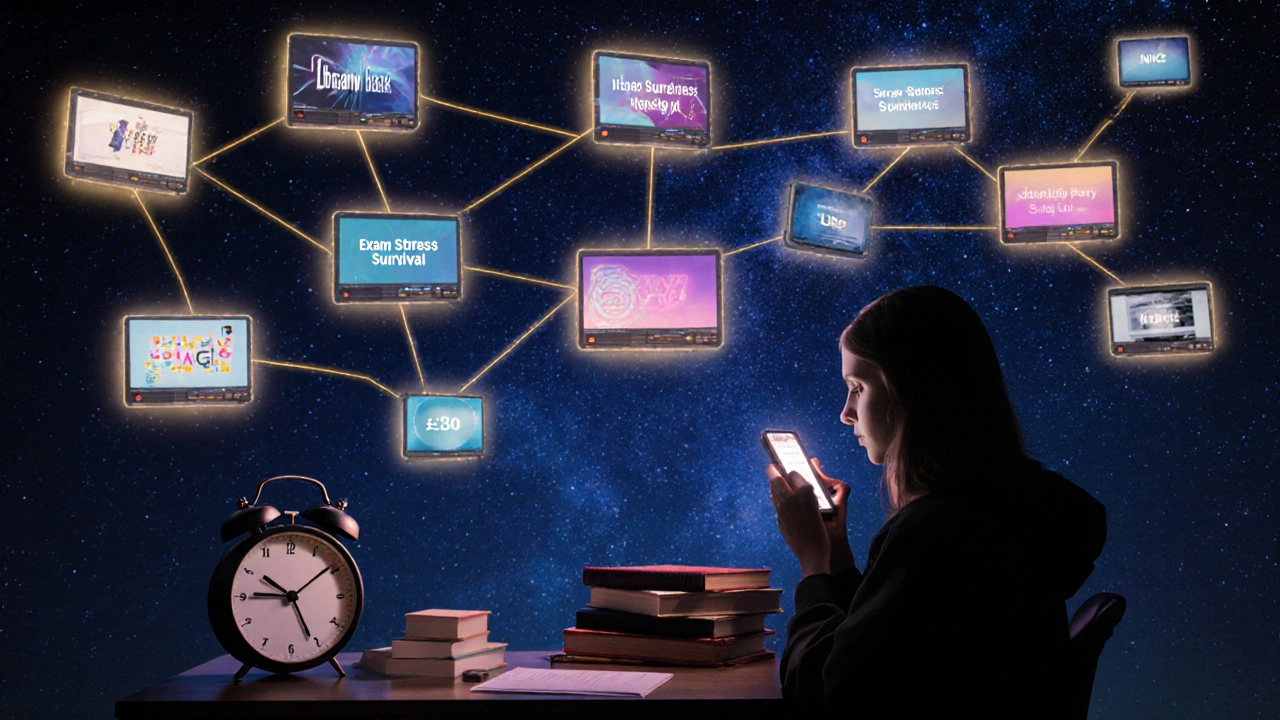
Starting a YouTube channel while studying in the UK isn’t just a side hustle-it’s a real skill builder. Thousands of students are already doing it: recording lectures in their own words, showing their study routines, reviewing textbooks, or just sharing what life’s really like between deadlines. But here’s the truth: most don’t stick with it. Not because they’re lazy. Not because they’re bad at filming. They just don’t know how to fit it into a packed schedule without burning out.
Why Students Are Turning to YouTube
It’s not about becoming famous. It’s about learning how to explain things clearly, manage time under pressure, and build confidence. A 2024 survey by the UK Student Union found that 68% of student YouTubers said their channel helped them understand their own course material better. When you teach something on camera, you force yourself to really get it. That’s why biology students in Manchester are making 10-minute videos on cell division, and economics students in Edinburgh are breaking down inflation with coffee shop whiteboards.
Plus, YouTube gives you a portfolio. Future employers don’t just care about your grades. They want to see communication skills, initiative, and consistency. A well-edited vlog showing how you revised for finals? That’s more memorable than a bullet point on a CV.
What You Actually Need to Start
You don’t need a 4K camera. You don’t need fancy lighting. You don’t even need a quiet room.
Here’s what works for most students:
- A smartphone with a decent camera (iPhone 12 or newer, Samsung S21 or newer)
- Free editing apps: CapCut (easiest), DaVinci Resolve (more control)
- A pair of basic earbuds with a mic (for clear audio)
- A small tripod or stack of books to hold your phone steady
- At least 15 minutes a day to record, even if it’s just talking to your phone while walking to class
One student in Leeds filmed her entire revision series while sitting on the bus. She used noise-cancelling earbuds to record herself explaining key theories. Her channel, Bus Study Notes, now has over 45,000 views. No studio. No lighting. Just consistency.
How to Pick a Niche That Actually Works
Don’t try to be everything. Don’t do "day in the life" unless you have something unique to say.
Here are five niche ideas that actually grow for UK students:
- Revision breakdowns - One topic per video. "How I passed Organic Chemistry in 3 days"
- Library hacks - Best quiet spots, how to reserve study rooms, where to find free coffee during exams
- Student budgeting - How I lived on £80 a week in London
- Course reviews - "Why I dropped Law and switched to Psychology"
- Exam stress survival - What actually helped me sleep before finals
These work because they solve real problems. People search for them. Google Trends shows "how to study for exams UK" has 2x more searches than "day in the life of a student". Pick a niche that helps someone else. That’s how you get recommendations.

Time Management: How to Vlog Without Falling Behind
You’re not going to film every day. You don’t have to.
Here’s the system most successful student creators use:
- Batch film on weekends - Record 3-4 videos in one afternoon. Use your phone’s voice memo app to script them while walking to the shops.
- Use your commute - Record audio explanations while on the train. Edit them later into videos.
- Set one weekly goal - "This week, I’ll post one 8-minute video." Not "I’ll post every day."
- Link videos to your studies - If you’re writing an essay on climate policy, turn part of it into a video. Kill two birds with one stone.
One student in Cardiff filmed her entire dissertation presentation as a YouTube video. She submitted it for her degree, then uploaded it. Got 12,000 views. Her professor asked if she’d share it with next year’s class.
What to Avoid (The Common Mistakes)
Here’s what kills student channels before they start:
- Waiting for perfect conditions - You don’t need silence, perfect lighting, or a green screen. Film in your dorm. Use natural light by the window.
- Comparing yourself to big creators - You’re not supposed to be MrBeast. You’re supposed to be the person who gets it. Your audience is other students, not millions of viewers.
- Posting too often - Two videos a month is better than one rushed video a week. Quality beats frequency.
- Ignoring captions - 80% of YouTube views happen without sound. Turn on auto-captions in YouTube Studio and fix the errors. It makes a huge difference.
- Chasing views - Focus on engagement. If three people comment "This helped me pass," that’s more valuable than 500 views with no interaction.

How to Keep Going When You Feel Like Quitting
There will be weeks you’re exhausted. You’ll have three deadlines. Your video got 12 views. You’ll think: "Why am I doing this?"
Here’s what keeps people going:
- Keep a "win log" - Every time someone says "This helped," save it. Read it when you’re low.
- Find one other student creator to chat with. Join the Student YouTubers Discord. Talk about what’s hard. You’re not alone.
- Remember: your channel is a learning tool. Even if it never hits 10,000 subscribers, you’ve already improved your speaking, editing, and critical thinking.
One student in Glasgow started her channel during a mental health break. She posted one video a month. Two years later, she got an internship at a media company because they found her videos. "They said I explained complex ideas like a pro," she told me. "I didn’t even know I was learning that skill."
What Comes Next?
After a year, you might start getting asked to review products, get free textbooks, or even collaborate with your university’s student union. That’s not the goal-but it’s a sign you’re doing something right.
Don’t rush monetization. Focus on building trust. Your audience isn’t looking for ads. They’re looking for someone who’s been where they are.
YouTube isn’t a distraction from your degree. It’s a way to learn it better. And if you stick with it, you’ll end up with something no degree can give you: proof you can create, communicate, and keep going-even when everything else feels overwhelming.
Can I make money from YouTube as a student in the UK?
Yes, but not right away. YouTube’s Partner Program requires 1,000 subscribers and 4,000 watch hours in the past year. Most students take 6-12 months to reach that. Don’t chase ads. Focus on building an audience first. Once you hit those numbers, you can enable monetization. Many student creators earn extra cash through affiliate links (like Amazon textbook links) or Patreon for exclusive study tips.
Do I need to show my face on camera?
No. Many successful student channels use screen recordings, voiceovers with slides, or just hands writing notes. Some use animated avatars or text-on-screen videos. Your voice and content matter more than your face. If you’re shy, start without showing yourself. You can always add your face later.
How long should my videos be?
For students, 5-12 minutes is the sweet spot. Shorter than 5 minutes? You won’t explain enough. Longer than 15? Most viewers lose focus. Start with 8 minutes. Edit tightly. Cut out "ums," pauses, and filler words. Viewers appreciate clarity over length.
Is it worth it if I’m not popular?
Absolutely. Popularity isn’t the point. The real value is in what you learn: how to structure thoughts, speak clearly, manage deadlines, and handle feedback. These are skills employers value. One student in Birmingham had only 200 subscribers but got a job interview because the hiring manager watched her video on time management. She didn’t need millions. She just needed to show she could do the work.
Can I use university lectures in my videos?
Only if you’re summarizing them in your own words and not recording the professor directly. Most universities own the rights to recorded lectures. But your personal explanations, examples, and study methods? Those are yours. Turn your notes into videos, not the lecture slides. That’s legal, ethical, and more helpful to viewers.
What if I fall behind on uploads?
It happens. Don’t panic. YouTube’s algorithm doesn’t punish you for breaks. What matters is consistency over time, not weekly uploads. If you miss a month, just come back with one strong video. Say something like, "Took a break during finals-here’s what I learned." Your audience will relate. They’re students too.
If you’re reading this and thinking about starting a channel, don’t wait for the perfect moment. Start with one video. Film it tonight. Upload it tomorrow. You don’t need permission. You don’t need a big audience. You just need to begin.